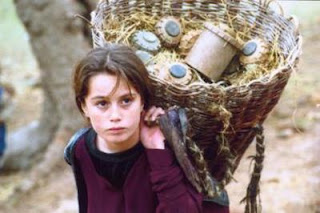Bertolt Brecht had once said ‘War is like love, it always finds a way’. In Iranian director Bahman Ghobadi’s third full-length feature film Turtles can Fly (2004), on the eve of the American invasion of Iraq, war has quietly crept into the lives of each of the residents of a Kurdish refugee camp situated on the Iraqi-Turkish border.
The children in the camp are all orphans. They, along with others from nearby villages, spend their days clearing the local peoples’ land of mines. These ‘American’ mines are then sold to the arms dealers in the neighbouring town. For such perilous work, they are paid a few dinars on a daily basis. Some of them have already lost one or more limbs in the process, but that has not deterred them from raising their hands when the localites want more landmines disarmed and collected.
The elderly are hankering after news of the war. They carry cross-like antennae on their world-weary shoulders only to find that there is no picture reception on their TV sets. Moreover, there is censorship—certain channels are ‘prohibited’; thankfully, not news channels.
And this is exactly where Satellite (Soran Ebrahim)—a 13–14-year-old boy comes in. As his nickname suggests, Satellite is adept at installing dish antennae. He also speaks broken English. For these two qualities he is hero-worshipped by a horde of children, especially Shirkooh; can get away with ordering others around, primarily Pashow; and is called to translate the English news in the presence of the governor of the village. A resourceful teenager, satellite knows which shopkeeper to approach to exchange radios (‘Radios are of no value anymore’) for a satellite dish. On behalf of his people, he even negotiates the price of mines. Satellite encourages others to pick up a few words of English, and eagerly awaits the arrival of the US
One day, Satellite meets a girl named Agrin (Avaz Latif), who approaches him for a length of rope to prevent the blind toddler Riga
Agrin, just like the other kids in the camp, has grown up way too fast. She has the responsibility of taking care of a blind tiny tot and a physically disabled elder brother. She pleads with Hengov to leave Riga Riga
The scythe of war ripping innocence apart has been visited often in other films—from the gut-wrenching and gritty Come and See (1985) that dealt with Byelorussia during World War II, to the emotion-soaked Grave of the Fireflies (1988) that depicted life in WWII Japan through the eyes of a brother and a little sister, to name just two. However, unlike those two films, in Turtles can Fly, war merely serves as the backdrop. Like an ominous shadow it looms large, and makes its presence felt via proxy. A kid playing with a gas mask, an open-air market from where children buy rifles and bullets, expended artillery shell casings stacked like drain pipes—no wonder in such a scenario, kids dream like adults. Some of them, like Shirkooh, want to earn more money; while others like Agrin, simply aspire to crossing the border.
In Ghobadi’s own words: ‘The slow-moving turtle is like the Kurds: With all of our problems, we have managed to move forward, and we always end up upright.’ But for me, the turtles were the children of the refugee camp. Each one of them carries a burden on his/her shoulders—be it the life-long scar of having lost a limb or two, having to harbour a secret deep within the recesses of the heart or at a more apparent level—Agrin, with little Riga hanging from her back.
The characters in Turtles can Fly lay a lot of emphasis on ‘seeing’—the elderly want to watch the news; Hengov is clairvoyant; in one scene Shirkooh tells Satellite that he had seen a nightmare; Agrin sees no future with Riga in tow; while Riga




No comments:
Post a Comment